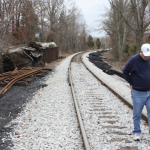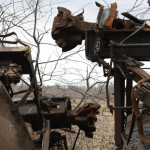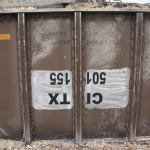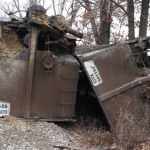 Amtrak is calling “all kids—young and old” to join the coast-to-coast celebration of train love. On Saturday, May 7th, hundreds of National Train Day festivities are taking place across the country including four major events in Washington, DC, Philadelphia, Los Angeles and Chicago. At each you can enjoy: Free live entertainment, Interactive and educational exhibits, Kids activities, Model train displays, Tours of Amtrak equipment, freight and commuter trains, and of notable private railroad cars, and much more. You can attend an event near you, host one of your own, or participate online. Start the celebration today at nationaltrainday.com.
Amtrak is calling “all kids—young and old” to join the coast-to-coast celebration of train love. On Saturday, May 7th, hundreds of National Train Day festivities are taking place across the country including four major events in Washington, DC, Philadelphia, Los Angeles and Chicago. At each you can enjoy: Free live entertainment, Interactive and educational exhibits, Kids activities, Model train displays, Tours of Amtrak equipment, freight and commuter trains, and of notable private railroad cars, and much more. You can attend an event near you, host one of your own, or participate online. Start the celebration today at nationaltrainday.com.
Category: News
Those of you who know a little about using scanners to listen in on radio communications while railfanning know that the industry is changing with CSX is poised to lead the way.
However, this may come at a hefty price to railfans – the adoption of FCC emission designator 4K00F1E, otherwise known as NXDN digital format – something that is not available in any current scanners (not even the high end digital ones).
The NXDN realization hit home early in 2011 here in Lafayette as callsign KEX475, otherwise known as CSX’s license for Shops Yard, was modified to include the new NXDN digital format. This same format is utilized by Christian County for all of it’s public safety communications, and will soon be utilized by Hopkins County public safety. The format is proving very prevalent as a cost alternative to the more universal APCO-25 (like that used by Kentucky State Police and numerous other states).
So is this the end of railroad scanning? No, not yet. The switch is still a ways out, but there’s more than one way to skin the proverbial cat… There is a software application that allows listeners to decode the NXDN format – a similar type setup like myself and Steve Miller utilize to decode the ATCS signals used on CSX’s CTC system. – Chris Dees
The “Old Goat” (Dennis Carnal) walks along the CSX Morganfield Branch, just west of Manitou, KY, where a loaded Dotiki unit coal train derailed in December, 2010, grounding seven aluminum 100-ton hoppers. – Photographs by Bill Thomas
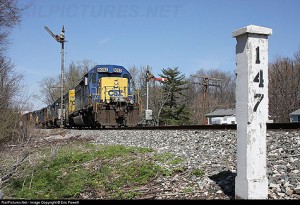 Remember the phrase “I love the smell of napalm in the morning” from one of those old war movies? Well fellow Hoosier Railfan, spent the morning of December 14, 2010, in Crawfordsville, watching CSX crews take down the remaining semaphores on the Monon Subdivision. Here’s his story from the North Central Indiana Railfan Yahoo Group.
Remember the phrase “I love the smell of napalm in the morning” from one of those old war movies? Well fellow Hoosier Railfan, spent the morning of December 14, 2010, in Crawfordsville, watching CSX crews take down the remaining semaphores on the Monon Subdivision. Here’s his story from the North Central Indiana Railfan Yahoo Group.
Northbound J726 was the last train to physically pass through the “blades” although they were all out of service by the time he came through late morning; the last train to actually use the authority granted by the semaphores would have been the northbound Hoosier State, which went through Crawfordsville in darkness and miraculously got to Lafayette only four minutes late.
The salvage crew started at Ames and took the blade and southbound color light signal down, then moved north. They weren’t too kind to the northbound semaphore at Main Street; it came down blade first, which wadded up the blade and shattered the red lens. After that, the boom operator was told to be a bit more gentle, which he most definitely was with the southbound signal.
Once the crews had the signals on the ground, the crews cut the mast just below the blade and motor and loaded it onto a truck; for a brief second, as the boom operator was lifting the blade/motor/finial/cut mast up onto the truck it was eerily similar to all the grisly severed heads in “Apocalypse Now.” Not pleasant.
After watching the “Nightmare at Main Street” I had enough and headed east toward Indianapolis, back to work and the “modern world”. The salvage trucks were on their way to the north side of town as I left. But my last memory of “shorty,” the short semaphore up at the north end of Crawfordsville, will forever be of J726 easing through with a friendly honk and wave from the hogger. I’m glad I decided to keep it that way.
Long Live The Monon, Eric Powell
FOR IMMEDIATE RELEASE
Local Historians Gathering Photographs and Information for a History of the Cadiz Railroad – Cadiz, Kentucky – December 27, 2010 – Although both William Turner and Thomas Harper are currently busy promoting their respective books, Edgar Cayce’s Hometown and Images of America: Trigg County, they have made time to begin research for their next project; a history of the Cadiz Railroad.
March 9, 2011, marks the 110th anniversary of the founding of the Cadiz Railroad, the 10.33 mile short-line that connected Cadiz and Trigg County to the world by way of nearby Gracey. Upon arrival in Gracey, Trigg Countians made their way to cities near and far aboard the Louisville & Nashville and the Illinois Central Railroads. In addition to passenger transportation, the Cadiz Railroad also carried livestock, tobacco, timber and other merchandise out of the county while delivering nearly every imaginable item to the merchants of Trigg County, and from 1902 to 1941, even the mail arrived aboard a Cadiz Railroad steam powered locomotive.
According to H. S. “Stan” White, Jr., several articles have been published over the years about the Cadiz Railroad, but they have often been riddled with errors or inflated by the authors for the purpose of “a good story”. White is working closely with Turner and Harper, contributing his personal archive of Cadiz Railroad business documents and photographs and through personal interviews; White is also writing the foreword to the upcoming book. Turner states that Stan White’s contribution to this publication is invaluable. “As President of the Cadiz Railroad from 1966 until his retirement in 1985, he [White] brings a one-of-a- kind perspective to the process of documenting the history of the railroad.”
William T. Turner has authored numerous books on various historical topics, including Images of America: Cerulean Springs and the Springs of Western Kentucky, with LaDonna Dixon Anderson. Turner opened his personal archives to Thomas Harper and provided guidance during the compilation of Harper’s first book, Images of America: Trigg County, which is set for release on February 21, 2011.
Turner and Harper are seeking information, photographs and personal accounts about the Cadiz Railroad. For more information or to contribute materials, please call 270-498-1212, 270-839-6380 or email trigghistory@gmail.com.
NORTONVILLE — Austin Nance, 22, was struck and killed by a CSX train as he was jogging on the tracks just north of here Thursday morning, according to a report from the Hopkins County Sheriff’s Department.
Deputies were dispatched to the tracks in the Little Valley area at 8:21 a.m., after Nance’s body was discovered by an unidentified local resident. It was unclear who summoned authorities, though personnel on the train saw the Nortonville man about to be hit, but were unable to stop. Hopkins County Coroner Dennis Mayfield arrived shortly thereafter and pronounced Nance dead.
Mayfield said Nance was killed on impact as a result of multiple blunt force trauma and that he believes the jogger was struck from behind.
“He was going southbound and so was the train,” said Mayfield.
Authorities have reason to believe Nance was jogging along the tracks based on a statement from the CSX train’s conductor who witnessed the accident. Nance’s family said the tracks were on his regular jogging route, according to Mayfield.
Due to the nature of the case, it was turned over to the Criminal Investigations section of the Sheriff’s Department, said Detective Scott Troutman.
Mayfield said Nance was taken to Reid-Walters Funeral Home in Earlington where funeral arrangements are incomplete.

